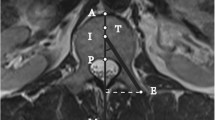Abstract
Objective
To evaluate the feasibility of the rotational angiography unit (RAU) as a single technique to guide percutaneous vertebroplasty (PVP).
Materials and methods
Twenty-five consecutive patients (35 vertebral bodies, 20 lumbar and 15 thoracic) were treated using RA fluoroscopy. Using a state-of-the-art flat-panel angiographer (Artis zee, Siemens, Erlangen, Germany), rotational acquisitions were obtained in all patients for immediate post-procedure 2D/3D reconstructions. Pre- and postoperative back pain was assessed with the visual analog scale (VAS). Fluoroscopy time, patient radiation dose exposure, technical success, mean procedure time, mean number of rotational acquisitions and procedural complications were recorded. All features were compared with a historical cohort of patients (N = 25) who underwent PVP under CT and mobile C-arm fluoroscopy guidance.
Results
In all cases, safe and accurate control of the needle insertion and bone-cement injection was successfully obtained with high-quality fluoroscopy images. One cement leakage was detected in the RAU group, and two leakages were detected in the CT and C-arm fluoroscopy group. Technical features were significantly different between the two groups (RAU vs. CT): mean procedure time: 38.2 min vs. 60.2 min (p = 0.02); median fluoroscopy time: 14.58 and 4.58 min (p = 0.02); median number of rotational acquisitions: 5 vs. 10 (p = 0.02); mean patient dose: 6 ± 1.3 mSv vs. 23 ± 1.3 mSv (p = 0.02). There were minor complications (pain, small hematoma) in two patients (8%) in the study group and three cases (12%) in the control group.
Conclusion
RAU guidance is an effective and safe technique for performing PVP because it reduces the procedural time and radiation exposure.



Similar content being viewed by others
References
Gangi A, Kastler BA, Dietemann JL. Percutaneous vertebroplasty guided by a combination of CT and fluoroscopy. AJNR Am J Neuroradiol. 1994;15(1):83–6.
Gangi A, Sabharwal T, Irani FG, Buy X, Morales JP, Adam A. Standards of practice committee of the society of interventional radiology. Quality assurance guidelines for percutaneous vertebroplasty. Cardiovasc Intervent Radiol. 2006;29(2):173–8.
Anselmetti GC, Marcia S, Saba L, et al. Percutaneous vertebroplasty: multi-centric results from EVEREST experience in large cohort of patients. Eur J Radiol. 2012;81(12):4083–6.
Anselmetti GC, Bonaldi G, Carpeggiani P, Manfrè L, Masala S, Muto M. Vertebral augmentation: 7 years experience. Acta Neurochir Suppl. 2011;108:147–61.
Kevin McGraw J, Cardella J, Barr JD, et al. Society of interventional radiology quality improvement guidelines for percutaneous vertebroplasty. J Vasc Interv Radiol. 2003;14:827–31.
European guidelines on quality criteria for computed tomography. Office for Official Publications of the European Communities, 1999, Luxembourg.
Mathis JM, Wong M. Percutaneous vertebroplasty: technical considerations. J Vasc Interv Radiol. 2003;14(8):953–60.
Peh WC, Gilula LA. Percutaneous vertebroplasty: indications, contraindications, and technique. Br J Radiol. 2003;76(901):69–75.
Eckel TS, Olan W. Vertebroplasty and vertebral augmentation techniques. Tech Vasc Interv Radiol. 2009;12(1):44–50.
Katsanos K, Sabharwal T, Adam A. Percutaneous cementoplasty. Semin Interv Radiol. 2010;27(2):137–47.
Amoretti N, Marcy PY, Lesbats-Jacquot V, et al. Combined CT and fluoroscopic guidance of balloon kyphoplasty versus fluoroscopy-only procedures. Skeletal Radiol. 2009;38(7):703–7.
Trumm CG, Jakobs TF, Zech CJ, et al. Vertebroplasty in the treatment of back pain. Radiologe. 2006;46(6):495–505.
Joemai RM, Zweers D, Obermann WR, Geleijns J. Assessment of patient and occupational dose in established and new applications of MDCT fluoroscopy. AJR Am J Roentgenol. 2009;192(4):881–6.
Kloeckner R, Santos DP, Schneider J, Kara L, Dueber C, Pitton MB. Radiation exposure in CT-guided interventions. Eur J Radiol. 2013;82(12):2253–7.
Pedicelli A, Rollo M, Piano M, Re TJ, Cipriani MC, Colosimo C, et al. Percutaneous vertebroplasty with a high-quality rotational angiographic unit. Eur J Radiol. 2009;69(2):289–95.
Braak SJ, van Strijen MJ, van Leersum M, van Es HW, van Heesewijk JP. Real-Time 3D fluoroscopy guidance during needle interventions: technique, accuracy, and feasibility. AJR Am J Roentgenol. 2010;194(5):W445–51.
Tam AL, Mohamed A, Pfister M, et al. C-arm cone beam computed tomography needle path overlay for fluoroscopic guided vertebroplasty. Spine (Phila Pa 1976) 2010;35(10):1095–9.
Leschka SC, Babic D, El Shikh S, Wossmann C, Schumacher M, Taschner CA. C-arm cone beam computed tomography needle path overlay for image-guided procedures of the spine and pelvis. Neuroradiology. 2012;54(3):215–23.
Komemushi A, Tanigawa N, Kariya S, Kojima H, Shomura Y, Sawada S. Radiation exposure to operators during vertebroplasty. J Vasc Interv Radiol. 2005;16(10):1327–32.
Amoretti N, Lesbats V, Marcy PY, et al. Dual guidance (CT and fluoroscopy) vertebroplasty: radiation dose to radiologists. How much and where? Skeletal Radiol. 2010;39(12):1229–35.
Tappero C, Barbero S, Costantino S, et al. Patient and operator exposure during percutaneous vertebroplasty. Radiol Med. 2009;114(4):595–607.
Laredo JD, Hamze B. Complications of percutaneous vertebroplasty and their prevention. Skeletal Radiol. 2004;33(9):493–505.
Martin DJ, Rad AE, Kallmes DF. Prevalence of extravertebral cement leakage after vertebroplasty: procedural documentation versus CT detection. Acta Radiol. 2012;53(5):569–72.
Conflict of interest statement
The authors declare that they have no conflict of interest and have no financial relationship with any organization in relation to this manuscript.
Author information
Authors and Affiliations
Corresponding author
Rights and permissions
About this article
Cite this article
Cannavale, A., Salvatori, F.M., Wlderk, A. et al. Percutaneous vertebroplasty with the rotational fluoroscopy imaging technique. Skeletal Radiol 43, 1529–1536 (2014). https://doi.org/10.1007/s00256-014-1925-3
Received:
Revised:
Accepted:
Published:
Issue Date:
DOI: https://doi.org/10.1007/s00256-014-1925-3




